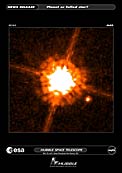Hubble spies possible brown dwarf around low-mass star
This NASA/ESA Hubble Space Telescope image shows one of the smallest objects ever seen around a normal star. Astronomers believe the object is a brown dwarf because it is 12 times more massive than Jupiter. The brown dwarf candidate, called CHXR 73 B, is the bright spot at lower right. It orbits a red dwarf star, dubbed CHXR 73, which is a third less massive than the Sun. At 2 million years old, the star is very young when compared with our middle-aged 4.6-billion-year-old Sun.
CHXR 73 B orbits 19.5 billion miles (about 31 billion kilometres) from its star, or roughly 200 times farther than Earth is from the Sun.
The star looks significantly larger than CHXR 73 B because it is much brighter than its companion. CHXR 73 B is 1/100 as bright as its star. The cross-shaped diffraction spikes around the star are artifacts produced within the telescope's optics. The star is 500 light-years away from Earth.
Hubble's Advanced Camera for Surveys snapped the image in near-infrared light on Feb. 10 and 15, 2005. The colour used in the image does not reflect the object's true colour.
Credit:About the Image
| Id: | heic0610a |
| Type: | Observation |
| Release date: | 7 September 2006, 19:00 |
| Related releases: | heic0610 |
| Size: | 322 x 322 px |
About the Object
| Name: | CHXR 73 A, CHXR 73 B |
| Type: | Milky Way : Star : Type : Brown Dwarf Milky Way : Star : Grouping : Binary |
| Distance: | 500 light years |
| Category: | Stars |
Wallpapers
Colours & filters
| Band | Wavelength | Telescope |
|---|---|---|
| Infrared I | 775 nm |
Hubble Space Telescope
ACIS |

